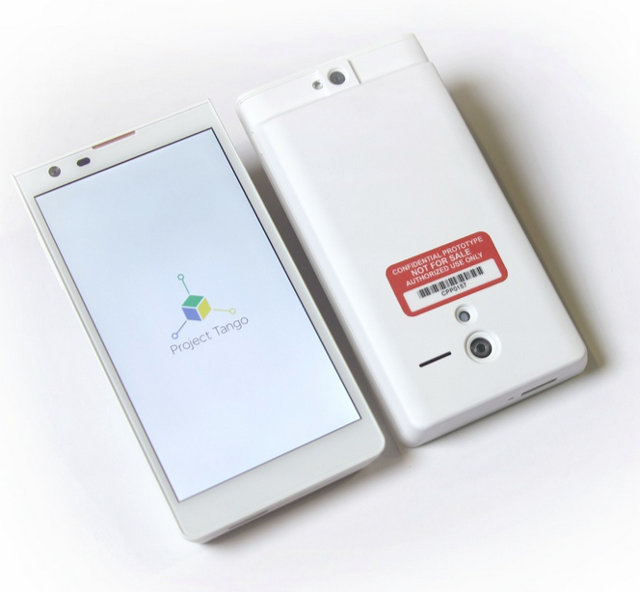Google ATAP (Advanced Technology and Products), the team who is currently working on Project Ara for Google, and recently moved from Motorola following the acquisition by Lenovo, has also been busy on another project called Tango, which centers around a phone equipped with cameras and sensors capturing 250,000 data points per second to track motion and generate 3D maps in real-time.
The prototype is 5” phone with hardware and software customization designed to simultaneously track the 3D motion of the device, and creating a 3D map of the environment. The device runs Android and includes development APIs to provide position, orientation, and depth data to standard Java, C/C++ Android. This is still early development, but the team imagine the technology could be used to easily create a 3D map of your home, facilitating furniture shopping. Other usa cses include indoor navigations, visually-impaired aid, and product location in a store. Augmented reality games could also leverage the technology. In some ways, it remind me of the demo of Intel’s RealSense technology at CES 2014 showing a tablet capture 3D models of physical objects.
The company is now looking for professional developers, incorporated entities or institutions only due to FCC regulations, who can create apps with this technology, and plan to send 200 prototype development kits to selected companies. They have allocated units for projects in the areas of indoor navigation/mapping, single/multiplayer games that use physical space, and new algorithms for processing sensor data, as well as some units for others applications. Kits will be sent by March 14th, 2014.
You can find more application about the project, and/or apply for a development kit on ATAP Tango page.
[Update: The hardware is based on Movidius Myriad 1 Mobile Vision Processor. Source :http://www.movidius.com/tango/]

Jean-Luc started CNX Software in 2010 as a part-time endeavor, before quitting his job as a software engineering manager, and starting to write daily news, and reviews full time later in 2011.
Support CNX Software! Donate via cryptocurrencies, become a Patron on Patreon, or purchase goods on Amazon or Aliexpress






You can build cheap DIY thermoelectric power generator yourself using one or multiple peltier:
https://en.wikipedia.org/wiki/Thermoelectric_generator
Combine this with a voltage regulator and a capacitor or battery then heat is all you need.
Google “thermoelectric generator” and there are plenty of tips for DIY builds based on cheap peltier elements from China.
This is not as good as it seems. First, a ten cent coin cell will last six years at the same current draw. Second this device has no peaking power. When your radio turns on it need a lots more power for a brief period of time. A battery can easily supply that, this device can’t do that so easily. With more research something like this might be useful, but right now I’d say stick with the ten cent coin cell.
@Jon : you havent read the entire presentation or dont understand what “energy harvester” are. Dont use them as a battery but instead like a charger. Use a capacitor or super capacitor to store energy produced by harvester, ans use it when needed.
@Singman They aren’t harvesting enough energy to be interesting. IOT SOCs have two power draws – a tiny trickle of standby current and a much larger current when they turn the radio on to transmit. Trying to maintain the standby current and simultaneously charge a battery/super cap with the available current is going to be might tricky. Add up the power output; it takes the largest cell six years to output the energy stored in a ten cent coin cell. And that assumes there is sufficient thermal gradient to achieve continuous full power output from the cell. I’m not saying… Read more »
Jon, I don’t think you understand this well enough. As the IoT expands it cannot possibly reach its potential with coin batteries. There is no way that all of them can be maintained or replaced year after year. To conceive of a network of billions of sensors deployed worldwide and having to change batteries as such sensors go down is virtually impossible without such an invention. This seems to be the solution to the 800lb gorilla the IoT faces. If you take a look a this company’s past products it appears they have a great deal of experience with devices… Read more »
@Jon Smirl
You are correct, too little power from the thermoelectric generators makes it not so practical, I would prefer solar cells or peizo electric generators
@Chris
Check out the Enocean stuff for something that is known to work.
https://www.enocean.com/en/enocean_modules/details/edk-312/
These things are in the $30 range per device.
And they are very limited in what they can do.